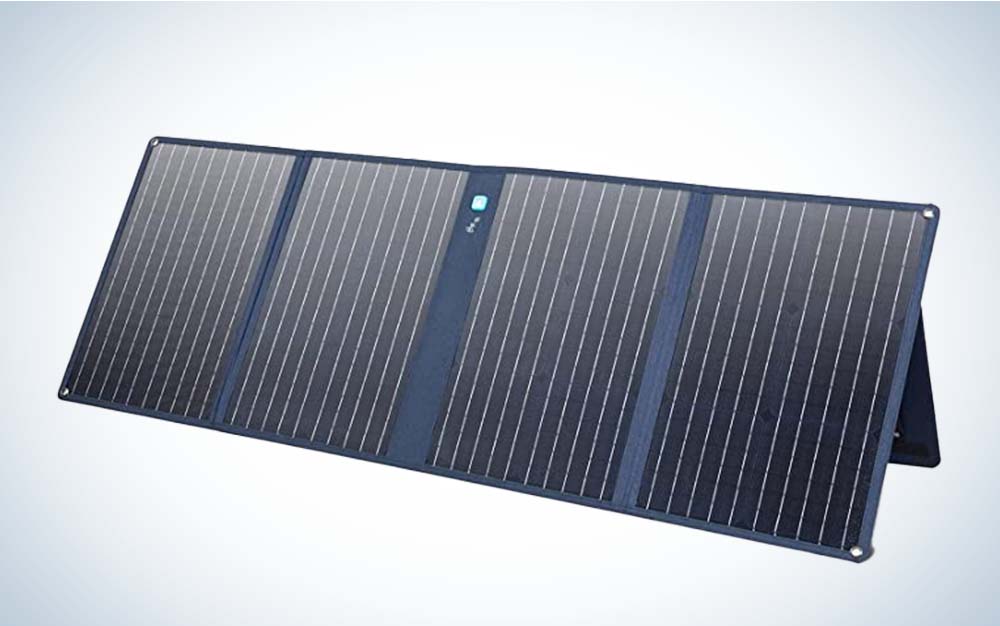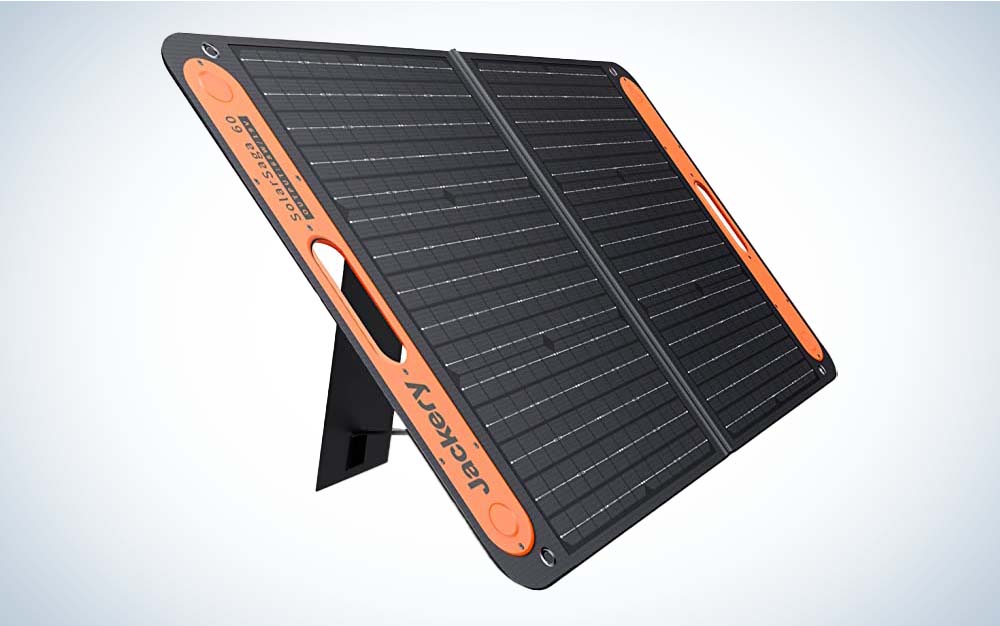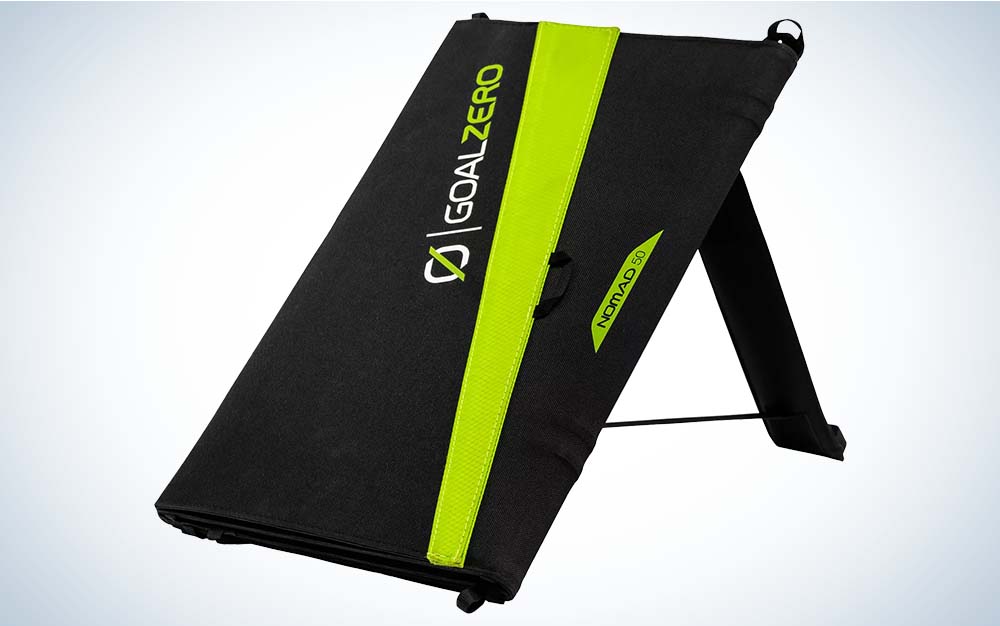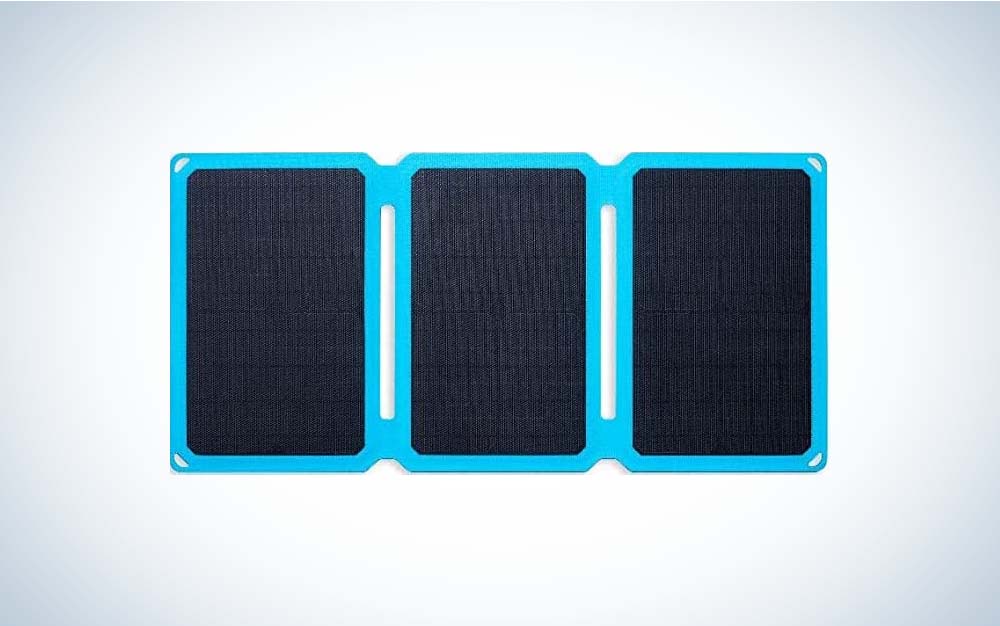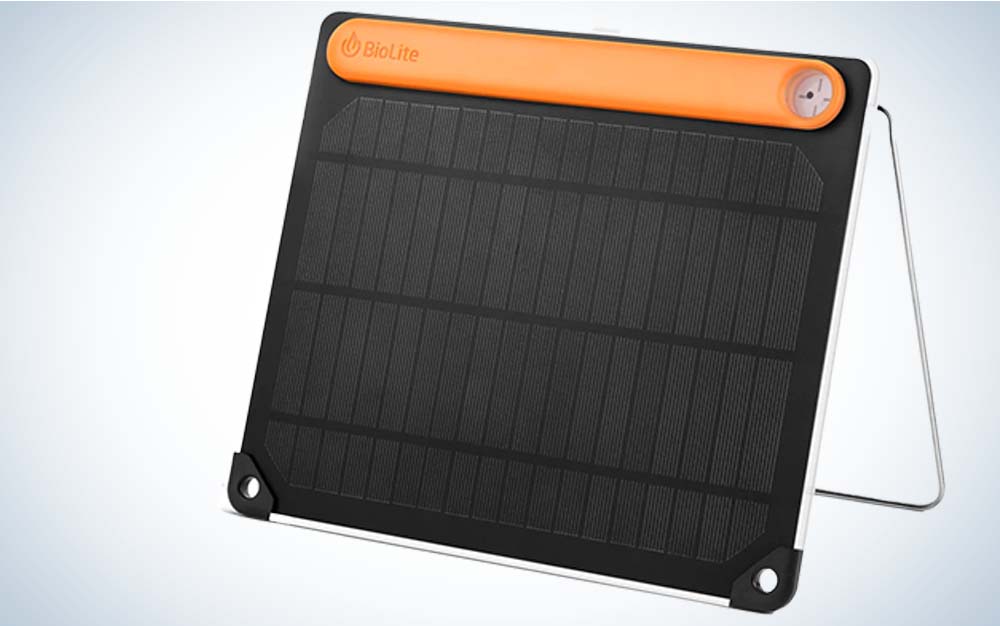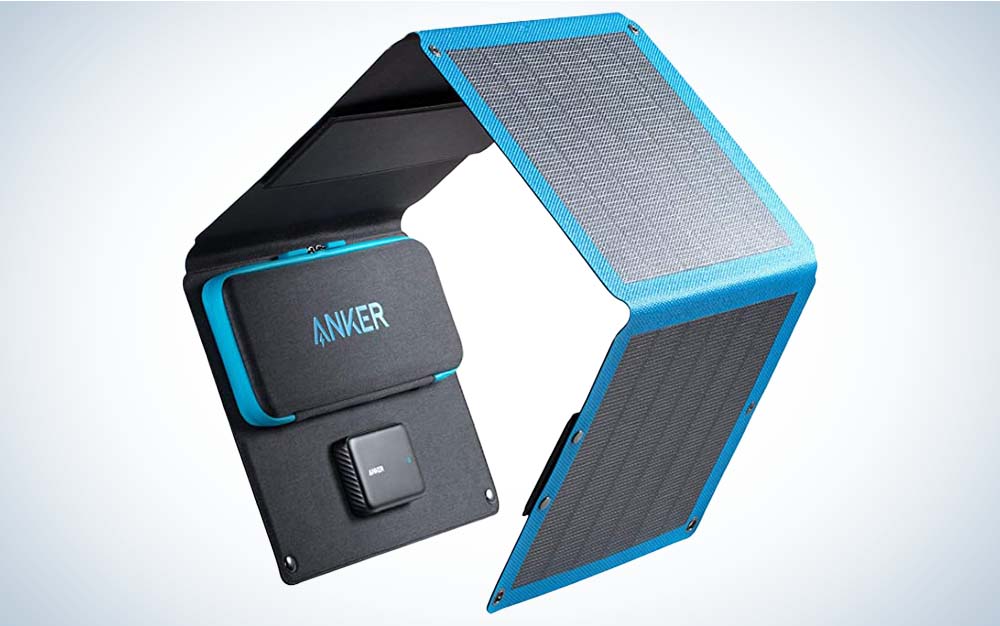We may earn revenue from the products available on this page and participate in affiliate programs. Learn More ›
Updated Mar 27, 2023 12:34 PM
Experienced campers know that you can get off the grid without having to ditch your electronics if you bring along a great solar panel that’s built for camping and outdoor environments. Modern panels have come a long way since the low amperage models of even a few years ago and with the right setup, you can power anything from a laptop to an electric cooler, with nothing more than a clear view of the sky on a sunny day (sometimes you don’t even need that). To find the best solar panels for camping, I put high-performing models from the top brands to the test:
How We Picked the Best Solar Panels for Camping
I tested solar panels for camping on a classic Pacific Northwest “Juneary” day. It should have been summer already, but it just wasn’t and wouldn’t be for a while. Solar panels were then evaluated on a number of criteria, including:
- Power Output: I tested each panel to see how long it took to charge my phone 5 percent. The larger panels were also tested on how long it took to charge a 32,000 mAh battery pack 5 percent, and whether the panel could charge both my phone and the battery pack at the same time. The battery pack used during this portion of the test was not the same brand as any of the products tested.
- Size: The size of the products I tested ranged from small panels that could crossover to backpacking all the way out to foldable four-panels arrays that can be chained together.
- Features: I considered the features of each solar panel in my test and the potential they had to improve the overall experience of the unit.
- Ease of Use: I considered how easy it was to set up and position each solar panel and how easy it was to break them down again for storage.
The Best Solar Panels for Camping: Reviews and Recommendations
Best Overall: Anker 625 Solar Panel
Key Features
- USB max output: 15W (5V)
- XT-60 port: 100W (26.5V)
- Weight: 11 pounds
- Ports: USB-A, USB-C, and XT-60 (includes both XT-60 to XT-60 cord and XT-60 to DC7909 connector)
- Dimensions: 56.9 inches x 20.7 inches x 1.8 inches (unfolded); 20.7 inches x 18.5 inches x 3.4 inches (folded)
- Warranty: 18 months
Why It Made the Cut
The high-power output of the Anker 625 makes this a smart, though expensive, investment for anyone looking to charge heavy duty appliances around the clock on their next camping trip.
Pros
- Strongest panel in my test, charged two devices simultaneously under very overcast skies
- Overpower protection
- Integrated sundial
Cons
- Expensive
- Less stable when set up than other panels in my test
Product Description
During the cloudiest part of my testing day, when dark gray clouds obscured the sun and the other solar panels packed it in, the Anker 625 was still able to charge my phone 5 percent in only five minutes. Then it powered up a 32,000 mAh battery pack 5 percent in a half hour under similar conditions. When I plugged both the battery pack and the phone in at the same time, it kept charging. If there is any chance of less-than-ideal weather on your camping trip, then this is the solar panel solution you’ve been looking for.

The Anker 625 was also only one of two solar panels in my test to incorporate an integrated sundial, which allowed me to optimize the positioning of the panel. This is helpful when it’s tough to distinguish the angle of the sun. Less helpful were the kickstands. Despite the nearly five-foot width of the four panels, there were only two kickstands provided, one on each end. This meant that the unit had a tendency to sag in the middle, and it moved more in the light breeze that blew during testing than other setups with a higher kickstand to panel ratio.
Most Stable: Jackery SolarSaga 60
Key Features
- USB max output: 12W (5V)
- DC port: 68W (19V)
- Weight: 6.6 pounds
- Ports: USB-A, USB-C, and 8mm DC
- Dimensions: 33.7 inches x 21.1 inches x 0.2 inches (unfolded); 16.7 inches x 21.1 inches x 1.38 inches (folded)
- Warranty: 2 years
Why It Made the Cut
The Jackery SolarSaga 60 had a one-to-one ratio of panels to kickstands, making it the most stable high-output solar panel in my test.
Pros
- Two panel array was both stable and easy to set up
- Great value
- Overpower protection
Cons
- Unable to power two devices in cloudy conditions
Product Description
Solar panels for camping have to hew a fine line between being compact enough to store on the go, but stable enough to withstand the elements. What impressed me most about the Jackery SolarSaga 60 during testing was how easy it was to set up, and once I had it set up, it just stayed put, unruffled by wind or me knocking into it as I fiddled with the other units. (Like the other solar panels in this test, it does need to be protected from rain.)

Once set up, the SolarSaga 60 did an excellent job powering my devices—even when the weather was cloudy, it charged my smartphone to 5 percent in five minutes. Unlike the more expensive Anker 625, however, it struggled to power two devices when plugged in during cloudy conditions.
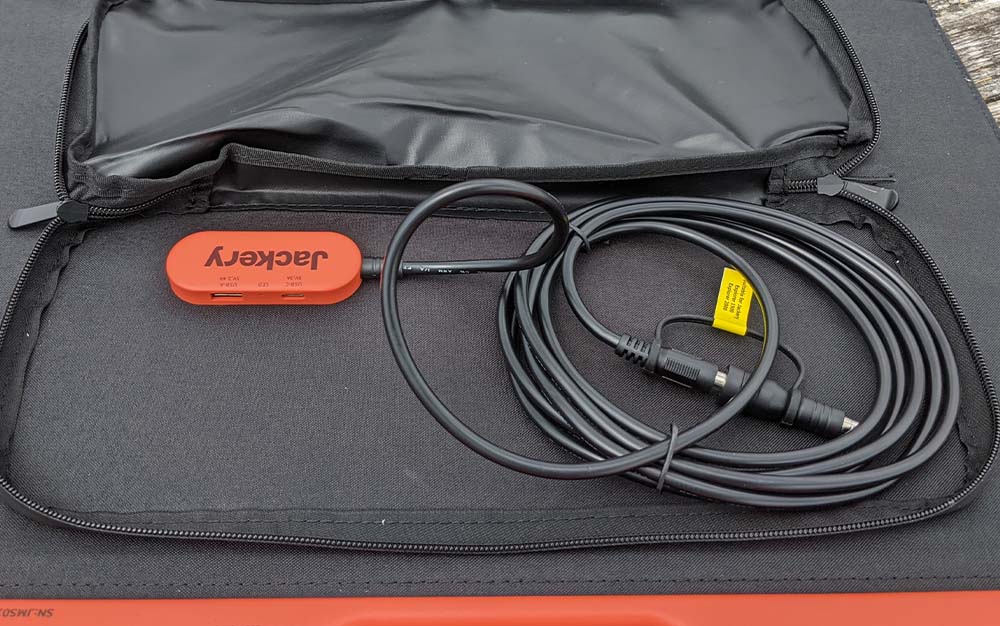
Because the SolarSaga 60 consists of two panels with two kickstands, it was the easiest large panel in my test to put away, simply folding up like a book with a magnet securing the edges together at the handle. If you need a high-power device that is simple to use, this one is hard to go wrong with.
Best for Chaining: Goal Zero Nomad 50
Key Features
- USB max output: 12W (5V)
- DC port output: 50W, chainable up to 150W (14-21.5V)
- Weight: 6.9 pounds
- Ports: USB-A and male 8mm
- Dimensions: 17 inches x 53 inches x 1.5 inches (unfolded); 17 inches x 11.25 inches x 2.5 inches (folded)
- Warranty: 2 years
Why It Made the Cut
Campers looking for even more power than the Anker 625 can instead choose to purchase three of the Goal Zero Nomads and chain them together for a maximum output of 150W.
Pros
- Easy to chain
- Compact size for a four-panel array
Cons
- Struggled to charge my phone during cloudy weather
Product Description
I’ll admit that once I started charging my smartphone and power banks for camping, it was easy to start getting carried away. What couldn’t I charge with just the power of the sun? But to really capture all that energy (especially if, like me, you live in an overcast part of the country) you’ll need more than the typical 50 or 60 watts of most panels. To facilitate (enable?) you to supercharge your solar powering capabilities, the Goal Zero Nomad 50 was designed to make it easy to chain multiple panels together with dedicated cords next to the port for this purpose.

On its own, a single Nomad 50 charged my phone 5 percent in just over five minutes but only once the weather started to clear out into a more manageable PNW monocloud. Under darker clouds it struggled to provide any power at all.
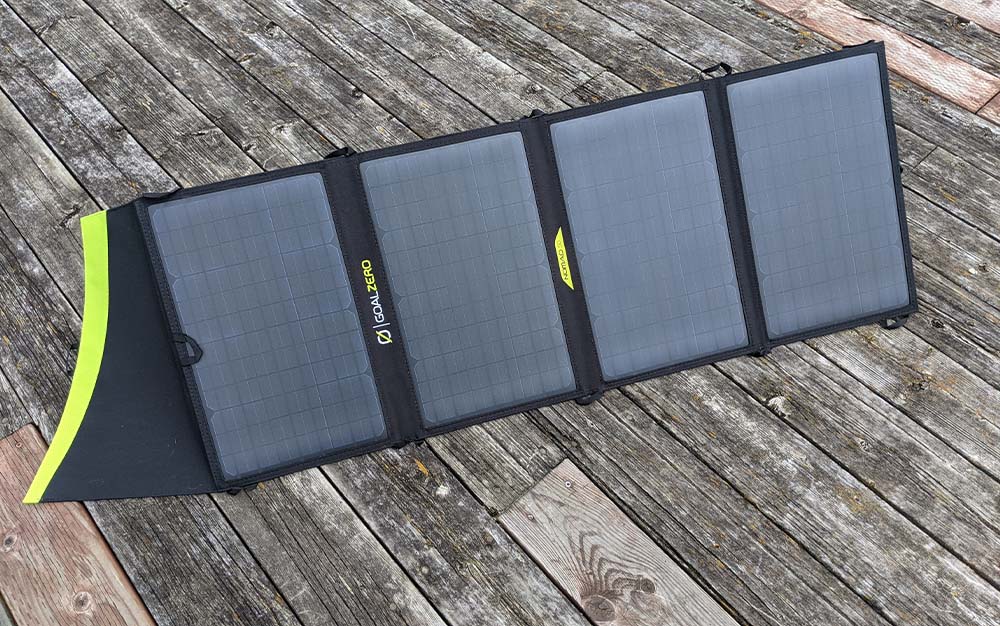
I liked how, despite it being a four-panel array, the Nomad 50 folded down relatively easily to about the size of a briefcase for travel and had a handy magnet to snap the packet together. With this one, it’s easy to start dreaming about adding on a few more panels to create a truly powerful array.
Best Crossover: GoSun SolarPanel 30
Key Features
- USB max output: 10W (5V)
- DC port: 30W (18V)
- Weight: 2.7 pounds
- Ports: USB-A and DC
- Dimensions: 29 inches x 14 inches (unfolded); 9.65 inches x 14 inches (folded)
- Warranty: 1 year
Why It Made the Cut
The GoSun Solar Panel 30 was the same size as my budget pick but also provided power output during the smartphone charging test that approached the larger panels.
Pros
- Lightweight enough to take backpacking
- Low profile for the wattage it provides
- Easy to use
Cons
- Struggled to provide power during cloudy weather
- No kickstands
- High price for its wattage output
Product Description
If you’re looking for a solar panel that can provide serious wattage for a backpacking trip (or that will take up virtually no space in your car), then the GoSun Solar Panel 30 might be the right pick for you. While this panel did not include a kickstand, making it a bit more of a chore to optimize the angle when the sun was low on the horizon, it was one of the more streamlined panels in my test and one of the best solar panels for camping that folded down to well under an inch. It would be no problem to squeeze this one into a hiking backpack for a low-key weekend trip.

While this panel was unable to charge my phone without direct sun, once the clouds thinned out enough that I could see my shadow on the ground, it worked fine, powering up my phone 5 percent in five minutes.
Best for Smartphones: BioLite SolarPanel 5+
Key Features
- Max power output: 5W
- Weight: 13.8 ounces
- Ports: USB-A
- Dimensions: 10.1 inches x 8.2 inches x 1 inch
- Also available in SolarPanel 10+
- Warranty: 1 year
Why It Made the Cut
This low-profile solar panel features a built-in battery large enough to recharge your smartphone after the sun sets.
Pros
- 3200mAh internal battery
- Affordable
- Small and lightweight
- Integrated sundial and adjustable kickstand
Cons
- Slowest charging time of the solar panels I tested
- Performs poorly in even slightly cloudy weather
Product Description
Not everyone is looking to charge an electric cooler or laptop while camping. Sometimes, you just want to juice up your phone a bit, so that you don’t have to monitor how much battery is left over the course of your trip.

The BioLite Solar Panel 5+ is essentially a low-cost alternative to a smaller battery pack. Its max output is only 5 watts, which, while too low to charge a larger battery pack, is ideal for charging a smartphone. I also liked that it featured an adjustable kickstand (the only one of the solar panels I tested) and an integrated sundial, which I used to optimize the positioning of the panel during testing. However, it still took the BioLite Solar 5+ 22 minutes to charge my phone 5 percent, even though it was sunnier (although still quite cloudy) than during other parts of my test. Unlike the other other panels, which could be used to spot charge a device on the go, the best and highest use of the BioLite is to charge the onboard 3,200 mAh battery (which can also be charged before leaving home via a micro USB port), speeding up your smartphone recharge so that you can get going again.
Best Budget: Anker 515 Solar Panel
Key Features
- Max output: 12W per port (5V)
- Weight: 2.5 pounds
- Ports: three USB-A
- Dimensions: 38.8 inches x 12.1 inches x 0.2 inches (unfolded); 9.6 inches x 12.1 inches x 2 inches (folded)
- Warranty: 18 months
Why It Made the Cut
The inexpensive Anker 515 solar panel provided three USB-A ports for charging, the most of any in my test.
Pros
- Low price
- Three USB-A ports for charging
- Lightweight and low profile
- Snaps hold the panels together during storage
Cons
- Was unable to charge my phone in cloudy weather
- Only kickstand to fall over in the wind
Product Description
While some campers set up their solar panel and battery configurations before their tent, for others it’s more of an afterthought or even a backup. If that sounds like you, the Anker 515 may provide just enough power to get you through that last day of camping at a significantly lower price point.

Something that sets the Anker 515 apart is that it wasn’t designed primarily for power banks. So instead of a difficult to match DC port or cable, it has three simple USB-A ports that can be used to power most small electronics (your smartphone, your partner’s smartphone, and one of the best camping fans for those hot summer nights). Due to its small size, it does need direct sunlight to power devices—it was unable to even charge my phone until the overcast skies started to thin out a bit.
Things to Consider Before Buying a Solar Panel for Camping
How Solar Panels Work
At its most basic, solar panels are made up of solar cells that convert sunlight into electricity. Each cell has two conductive layers, in between which are two different types of silicone—one with extra electrons, and one with space for electrons. When sunlight hits a solar panel, it sends a photon slamming into a solar cell, which in turns knocks one of the extra electrons loose. When that electron makes its way over to one of the silicone layers with space for electrons it creates a positive charge on one side and a negative charge on another. The solar cell channels the movement of the electrons, so that it can capture the energy it produces as it moves. While the amount of energy captured by each solar cell is negligible, when strung together in a solar panel, it can be quite impressive, with some of the solar panels in my test able to produce as many as 100W.
Some solar panels are better at regulating this output of energy than others, which matters when you are trying to capture this energy on the other side, whether in a power bank or directly into a device like some of the best solar generators. For instance, if you try to charge your smartphone on a port that can output 20V of power, then there is a good chance that you’ll damage the battery of your phone, even if in the moment it appears that your phone is simply charging extremely quickly. The solar panels in my test limited the voltage output from the USB ports (5V or less), while the DC ports, which are intended to pair with one of the best power banks for camping, provided a higher voltage output (between 14.5V and 26.5V). While this provides some protection against accidentally overcharging your devices, it’s still worth knowing how the max voltage output of each solar panel port compares to what your device’s or power bank’s battery can handle.
Power Output
While there are differences in the power ratings between solar panels, generally speaking, the larger a solar panel is, the more power it will generate. This is why solar panels for camping are typically folded twice or more—to maximize the amount of surface area they can cover when in use, while also minimizing the amount of space they occupy during transit.
Packed Size
While most people have plenty of room to spread out a solar panel unit at camp, the same can not always be said of the vehicle you use to get to get there. If your space is limited, the weather is predictable, and your power needs are low, consider a smaller solar panel.
External Battery
Many of the best solar panels for camping are designed to pair with a power bank for camping. This is because most solar panels do not have a way to store the electricity they generate when the sun is shining for those times when it’s overcast or slightly cloudy. Further, since the USB ports on most solar panels for camping limit the voltage output—to prevent inadvertent damage to the battery of smaller electronics, it’s important to ensure that your solar panel has a port that matches the high voltage output port of your power bank.
Chaining Solar Panels
To maximize the power captured in a battery pack during the sunniest portion of the day, some campers may opt to link, or chain together, multiple solar panels into a single array.
FAQs
Q: How much do solar panels for camping cost?
Solar panels for camping can cost anywhere from $80 to over $300, depending on the size and quality of the panels.
Q: What size solar panel is good for camping?
The size solar panel that is best for camping depends on what you are trying to charge with it. If you are looking to charge a smartphone, then a smaller single panel (with an accompanying battery) is all you’ll need to get going. If you have multiple appliances or devices that you are looking to charge, then a triple or quadruple panel setup (or even an array chained together) will work better.
Q: Can a solar panel overcharge a battery?
If you try to charge your smartphone on a port that can output 20V of power, then there is a good chance that you’ll damage the battery of your phone, even if in the moment it appears that your phone is simply charging extremely quickly. The solar panels in my test limited the voltage output from the USB ports (5V or less), while the DC ports, which are intended to pair with a battery pack, provided a higher voltage output (between 14.5V and 26.5V). While this provides some protection against accidentally overcharging your devices, it’s still worth knowing how the max voltage output of each solar panel port compares to what your device’s or power bank’s battery can handle.
Why Trust Outdoor Life?
Since 1898, OL has been a leading authority in testing and reviewing hunting gear, fishing tackle, guns and shooting equipment, and much more. We have more than a century-long history of evaluating products, and we’re now bringing that expertise to online reviews. Our editors are experienced outdoorsmen and women, and most importantly, we’re trained journalists. We prioritize field testing and objective data when reviewing products. We conduct interviews with gear manufacturers and engineers as well as outdoor experts so that our readers have an understanding of how and why a product works—or doesn’t.
Advertising does not influence our gear reviews and it never will. While we always focus our coverage on standout products—because we want our readers to be aware of the latest and greatest gear—we also cover the flaws and quirks of any given product.
Final Thoughts
After testing the best solar panels for camping from Jackery, Anker, Goal Zero, BioLite, and GoSun, the Anker 625 claims the top spot. If you’re only looking to power a smartphone, either the Anker 515 or the BioLite 5+ will provide sufficient juice at a lower cost (and a slower speed).

